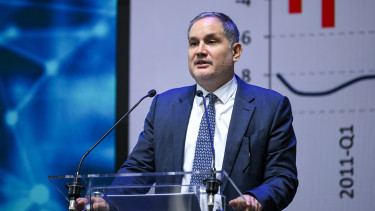Economy
Hungary does not receive much of an incentive to adopt euro
Two key proposals
The European Commission has already unveiled its proposals for the 2021-2027 Multi-annual Financial Framework (MFF) on 2 May, so we already knew that despite a recommendation by French President Emmanuel Macron, an investment stabilisation function would be launched with a relatively small EUR 30 bn budget, and a fund supporting member states’ structural reforms would be given a budget of EUR 25 bn.The Commission has no revealed details about the rules pertaining to these two.
“Both proposals are part of the broader agenda to deepen Europe's Economic and Monetary Union and make use of the EU budget to strengthen the performance and resilience of our interdependent economies," the EC said.
There are three principles at the core of the proposals: unity, efficiency and democratic accountability. The proposals announced late on Thursday “will firmly anchor the euro area into the Union's long-term budget."The Reform Support Programme will support priority reforms in all EU Member States, with an overall budget of EUR 25 billion. It comprises three elements: a Reform Delivery Tool, to provide financial support for reforms; a Technical Support Instrument, to offer and share technical expertise; and a Convergence Facility, to help Member States on their way to joining the euro.
The EUR 30 bn European Investment Stabilisation Function will help stabilise public investment levels and facilitate rapid economic recovery in cases of significant economic shocks in Member States of the euro area and those participating in the European Exchange Rate Mechanism (ERM II). This Function will complement the role of existing national automatic stabilisers. Subject to strict criteria of sound macroeconomic and fiscal policies, loans of up to EUR 30 billion can be rapidly mobilised, together with an interest rate subsidy to cover their cost.
On Tuesday, the Commission detailed rules of cohesion fund allocations:
Reform Support Programme: Here’s the “carrot".
The proposed Reform Support Programme will provide financial and technical support to all EU Member States in order to pursue and implement reforms aimed at modernising their economies, notably reform priorities identified in the context of the European Semester. Targeted support will also be offered to those Member States wishing to join the euro. The Reform Support Programme will have an overall budget of €25 billion and will support reform efforts in areas such as product and labour markets, education, tax systems, capital markets, business environment as well as investment in human capital and public administration reforms. The Reform Support Programme will be open to all Member States which wish to benefit from it.• It includes three separate and complementary instruments:
- A Reform Delivery Tool to provide financial support for key reforms identified in the context of the European Semester, with EUR 22 billion available to all Member States. Intense dialogue has taken place in recent months with the Member States on how to develop this new instrument in the future, including by rolling out a pilot project with Portugal.
- • A Technical Support Instrumentto help Member States design and implement reforms and to improve their administrative capacity. This builds on the experience of the Structural Reform Support Service, which has supported over 440 reform projects in 24 Member States in recent years. The tool is available to all Member States and has a budget of EUR 0.84 billion.
- • A Convergence Facility of EUR 2.16 billionthat will provide dedicated financial and technical support to Member States having made demonstrable steps towards joining the euro. This Facility does not alter the criteria in place for accession to the euro but it will provide practical support to ensure a successful transition towards, and participation into, the euro for those Member States wishing to join.
European Investment Stabilisation Function
The proposal to establish a European Investment Stabilisation Function aims to protect public investment in the event of large asymmetric shocks and help the economy rebound quickly. As shown by the crisis years, existing national stabilisation mechanisms may not be sufficient to absorb certain macroeconomic shocks and there are often risks of negative spill-over to other countries, with a particularly damaging impact on public investment levels and the real economy. This new instrument is focused on euro area Member States and countries participating in the exchange rate mechanism ERM II, which can no longer use their monetary policy as a lever for adjustment to shocks.The new Function will complement the toolbox existing at national and European level to prevent crises from emerging on the one hand, including through the European Semester and corresponding EU funding, and to deal with situations of financial distress, through the European Stability Mechanism and Balance of Payments assistance, on the other.
In the event of large asymmetric shocks, this Function will:
- Provide up to EUR 30 billion in back-to-back loans guaranteed by the EU budget. To minimise risks of moral hazard, Member States will have to comply with strict eligibility criteria based on sound financial and macroeconomic policies. The loans will give extra financial support at a time when public finances become stretched and should be geared towards maintaining growth-friendly public investments, which will in turn keep more people in jobs and enable the economy to recover more quickly.
- Include a grant component to cover the full costs of the interest. A new Stabilisation Support Fund will be set up in order to collect contributions from Member States equivalent to a share of their monetary income from the assets they hold in exchange of the banknotes they supply (commonly known as "seigniorage"). The revenues of this Fund will be assigned to the EU budget to provide the interest rate subsidies to the eligible Member States. Such an interest rate subsidy is important to make the instrument financially meaningful.
As set out in December 2017, this stabilisation function can be complemented over time by additional financing resources outside the EU budget, such as a possible role for the European Stability Mechanism or the future European Monetary Fund, and a possible voluntary insurance mechanism to be set up by the Member States. The Stabilisation Support Fund can also serve as a vehicle in this context.
Background
Today's proposals build on the vision set out in the Five Presidents' Reportof June 2015, the Reflection Papers on the Deepening of the Economic and Monetary Unionand the Future of EU Financesof spring 2017, the Commission's Roadmap for deepening Europe's Economic and Monetary Union and the Communication on new budgetary instruments for a stable euro area within the Union framework of 6 December 2017, as well as the Communication on the next Multiannual Financial Framework of 2 May 2018.These proposals are part of the ongoing process to strengthen and deepen Europe's Economic and Monetary Union. All reforms initiated so far have been driven by the need to combine solidarity and responsibility at all levels and this is also a central priority of today's proposals. They are part of President Juncker's broader Roadmap for a more United, Stronger and more Democratic Union as well as the resulting Leaders' Agendaon the road to Sibiu, where on 9 May 2019 important decisions on the future of Europe should be taken. The proposals are presented ahead of the inclusive Euro Summit on 28-29 June 2018 where EU leaders will meet with a view to taking decisions before the European parliament elections in 2019.
Front page photo by MTI/EPA Olivier Hoslet








